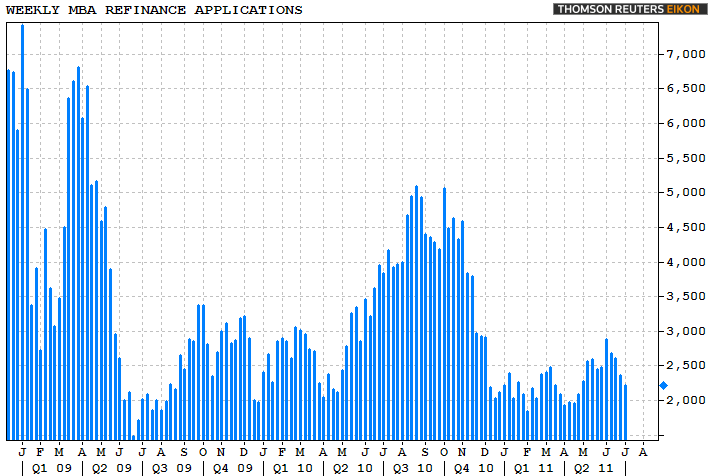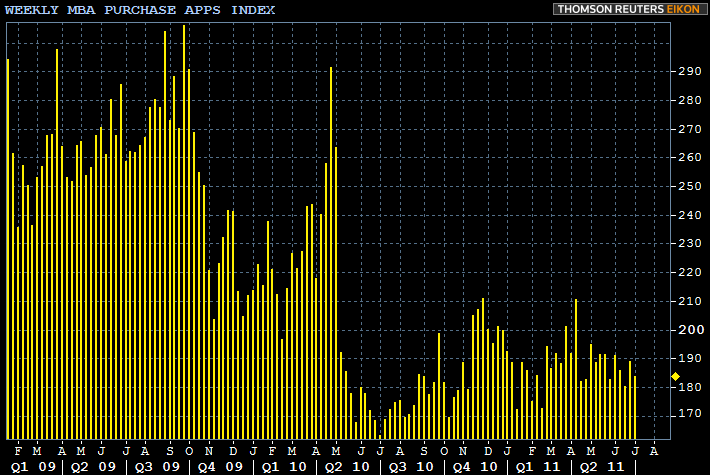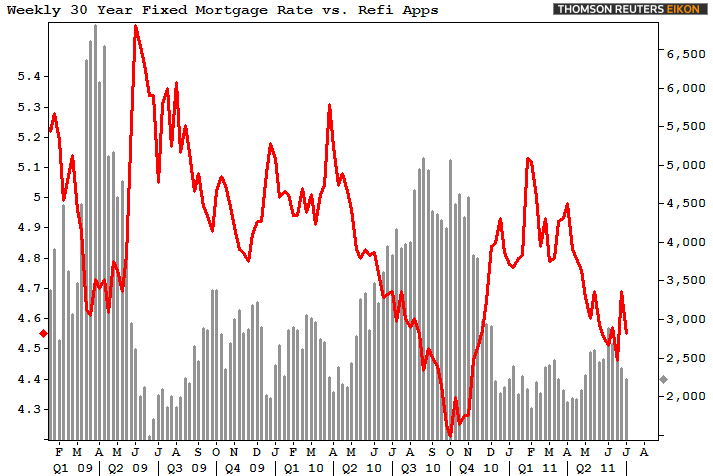Blog

Broken Record: Home Loan Demand Stagnate
The Mortgage Bankers Association (MBA) today released its Weekly MortgagernApplications Survey* for the week ending July 8, 2011. This week’s results include an adjustment tornaccount for the Fourth of July holiday. </p
Excerpts from the Release…</p
The Market Composite Index, a measure of mortgage loan application volume,rndecreased 5.1 percent on a seasonally adjusted basis from one weekrnearlier. On an unadjusted basis, thernIndex decreased 24.0 percent compared with the previous week. The fourrnweek moving average is down 4.7percent.</p
The Refinance Index decreased 6.2 percent from the previous week, and wasrn42.1 percent lower than a year ago. ThernRefinance Index has decreased the past four consecutive weeks, reaching itsrnlowest level since April 29, 2011. The Refinance Index is not seasonallyrnadjusted but is adjusted for the holiday. rnThe four week moving average is down 6.3 percent.</p
 </p
</p
The seasonally adjusted Purchase Index decreased 2.6 percent from one weekrnearlier. The unadjusted Purchase Index decreased 21.9 percent compared with thernprevious week and was 0.2 percent lower than the same week one year ago. Thernfour week moving average is down 1.0 percent.</p
 </p
</p
The average contract interest rate for 30-year fixed-rate mortgagesrndecreased to 4.55 percent from 4.69 percent, with points increasing to 0.99rnfrom 0.90 (including the origination fee) for 80 percent loan-to-value (LTV)rnratio loans. The effective rate alsorndecreased from last week.</p
The average contract interest rate for 15-year fixed-rate mortgages decreasedrnto 3.68 percent from 3.79 percent, with points increasing to 1.10 from 0.88rn(including the origination fee) for 80 percent LTV loans. The effective raternalso decreased from last week.<br /<br /The refinance share of mortgage activity decreased to 65.6 percent of totalrnapplications from 66.4 percent the previous week. The adjustable-rate mortgagern(ARM) share of activity decreased to 5.5 percent from 6.1 percent of totalrnapplications from the previous week.</p
 </p
</p
The broken record is still stuck….</p
Over a month ago we wrote, “Right now we’re witnessing the beginnings of a mini-refinance boom in the primary mortgage market, but there has been little activity in the secondary market that would indicate increased rate locking by consumers.” says MND’s Managing Editor Adam Quinones. “However, if conventional 30-year rates reach 4.25%, we’d expect to see a mini-boom scenario play out. There is much stored demand in the system as many borrowers missed the boat on record low rates in October and early November. This crowd is waiting in the wings for those rates to return. Whether or not that happens is still very much up in the air” </p
In reaction to that comment, Ted Rood,rn a loan originator from MetLife Home Loans added, “One thing to considerrn regarding refi volume is that HUD effectively ended FHA streamlines over the course of the last year by tightening underwriting guidelines and jacking up monthly MIP fees. After the change, many existing FHA clients have been unable to meet net benefit rules, even when dropping their rate by 1% or more, since their monthly MIP would double on the new loan. So FHA clients don’t get to benefit from lower rates and HUD doesn’t get new upfront MIPs from existing clients with clean payment histories who want to refinance”.</p
Plain and Simple: Mortgage rates have fallen but loan demand hasn’t reacted as one might expect (same old story). A combination of low to negative home-equity levels and tighter lender underwriting guidelines and weak consumer credit profiles are preventing responsible homeowners from reducing their monthly loan payments. Prospective homebuyers would rather “wait and see” if home prices have stabilized yet. Loan demand is stagnant. We have described this as a negative feedback loop. </p
READ MORE: New FHA MIP Structure to Slow Streamlines</p
READ MORE: Rents Seen Rising as Poor Credit HurtsrnHomeownership Demand</p
READ MORE: Realtors Request Looser Credit Regs as HomernSales Decline</prn
* ABOUT: The MBA’s loan application survey covers over 50% of allrnU.S. residential mortgage loan applications taken by mortgage bankers,rncommercial banks, and thrifts. The data gives economists a snapshot view ofrnconsumer demand for mortgage loans. In a falling mortgage rate environment, arntrend of increasing refinance applications implies consumers are seeking outrnlower monthly payments. If consumers are able to reduce their monthly mortgagernpayment and increase disposable income through refinancing, it can be arnpositive for the economy as a whole (may boost consumer spending. It alsornallows debtors to pay down personal liabilities faster. A trend of decliningrnpurchase applications implies home buyer demand is shrinking.
All Content Copyright © 2003 – 2009 Brown House Media, Inc. All Rights Reserved.nReproduction in any form without permission of MortgageNewsDaily.com is prohibited.
Latest Articles
By John Gittelsohn August 24, 2020, 4:00 AM PDT Some of the largest real estate investors are walking away from Read More...
Late-Stage Delinquencies are SurgingAug 21 2020, 11:59AM Like the report from Black Knight earlier today, the second quarter National Delinquency Survey from the Read More...
Published by the Federal Reserve Bank of San FranciscoIt was recently published by the Federal Reserve Bank of San Francisco, which is about as official as you can Read More...

Comments
Leave a Comment